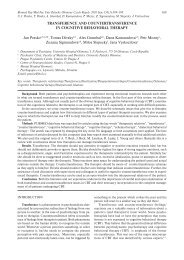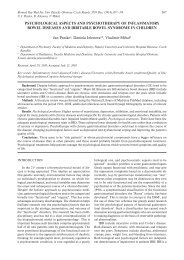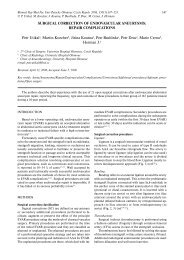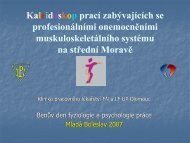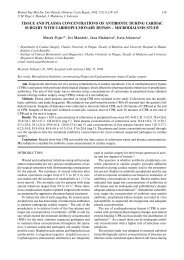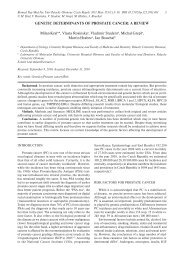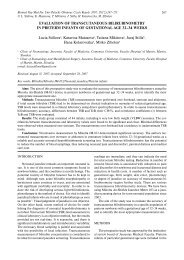APPROACHES TO MESSENGER RNA DETECTION - ResearchGate
APPROACHES TO MESSENGER RNA DETECTION - ResearchGate
APPROACHES TO MESSENGER RNA DETECTION - ResearchGate
Create successful ePaper yourself
Turn your PDF publications into a flip-book with our unique Google optimized e-Paper software.
Approaches to messenger <strong>RNA</strong> detection – comparison of methods135SWOT: Strength: Method is elegant, safe, simple touse, and requires only minimum experience and skills.It provides maximum sensitivity of all three discussedmethods (approx. 10 000 times more sensitive than NB)and among them it is the only one allowing quantification.Weakness: This method is the most expensive: Lightcyclerapparatus, fluorescently labeled primers, and m<strong>RNA</strong>isolation kits are the principal costs. There is a need ofhighly pure samples to be used, free of organic solvents,often present after Trizol isolation increasing the needfor alternative isolation procedures. Opportunity: Owingto its high sensitivity, a large number of genes can beanalysed from a single m<strong>RNA</strong> preparation. Threat: Theselection and design of the primers must be done carefullybecause of the possibility, albeit minuscule, thatother homologous genes may be detected. The risk of<strong>RNA</strong> degradation, until the reverse transcription stepis performed, is high because of water used as solvent.Contamination of <strong>RNA</strong> by fragments of genomic DNAcan occur if Trizol is used for extraction. Consequently, itcannot be distinguished whether genomic DNA or reversetranscript are detected.CONCLUSIONWith the human genome now available a principalquestion was raised: what do all those genes do? In view ofmany a researcher this question translates primarily intothe problem of: Are all those genes transcribed? It meansto look for m<strong>RNA</strong> occurrence within a cell as many ofthe genes may be cell type specific. Area of genomics isnot the only one with craving for m<strong>RNA</strong> data. The threemethods described herein are the tools currently availablefor a researcher to deal with a particular problem involvingm<strong>RNA</strong>.We offer a SWOT analysis in attempt to help othersduring pros and cons consideration when selectinga method for their purpose. Things to consider areobviously intertwined as specificity of each method islinked to financial demands together with health and environmentalrisks. An ideal of a highly specific, safe, andinexpensive method for m<strong>RNA</strong> detection does not exist.Quite often combination of two, out of the three methodsdiscussed, is utilized in many a lab throughout the world.This is important especially in pilot studies in order toconfirm data obtained. Therefore we recommend to haveone of these methods for routine use as the core methodand then to select another one not as an alternative butas a confirmation tool.ACKNOWLEDGEMENTThe authors gratefully acknowledge financial supportfrom the Ministry of Education of the Czech Republic grantMSM 151100003.REFERENCES1. Chomczynski P, Sacchi N. (1993) Single-step method of <strong>RNA</strong>isolation by acid guanidinium thiocyanate-phenol-chloroformextraction. Anal Biochem 162, 156–9.2. Kingston RE. (1993) Preparation of Poly(A) + <strong>RNA</strong>. In: CurrentProtocols in Molecular Biology (Eds.: Ausubel EM, Brent R,Kingston RE, Moore DD, Siedman JG, Smith JA, Struhl K),p 4.5.1.–4.5.3. John Wiley and Sons, New York, NY, 1993.3. Brown T. (1993) Analysis of <strong>RNA</strong> by Northern and Slot BlotHybridization. In: Current Protocols in Molecular Biology (Eds.:Ausubel EM, Brent R, Kingston RE, Moore DD, Siedman JG,Smith JA, Struhl K), p 4.9.1.–4.9.14. John Wiley and Sons, NewYork, NY, 1993.4. Gilman M. (1993) Ribonuclease protection assay. In: CurrentProtocols in Molecular Biology (Eds.: Ausubel EM, Brent R,Kingston RE, Moore DD, Siedman JG, Smith JA, Struhl K),p 4.7.1.–4.7.8. John Wiley and Sons, New York, NY, 1993.5. Melton DA, Krieg PA, Rebagliati MR, Maniatis T, Zinn K, GreenMR. (1984) Efficient in vitro synthesis of biologically active<strong>RNA</strong> and <strong>RNA</strong> hybridization probes from plasmids containinga bacteriophage SP6 promoter. Nucleic Acids Res 12, 7035–56.6. Rottman JB. (2002) The ribonuclease protection assay: a powerfultool for the veterinary pathologist. Vet Pathol 39, 2–9.7. Erlich HA. (ed.) (1989) PCR Technology: Principles and Applicationsfor DNA amplification. Stockton Press, London.8. Wilkening S, Bader A. (2003) Influence of culture time on theexpression of drug-metabolizing enzymes in primary human hepatocytesand hepatoma cell line HepG2. J Biochem Mol Toxicol 17,207–13.9. Wilkening S, Stahl F, Bader A. (2003) Comparison of primaryhuman hepatocytes and hepatoma cell line HepG2 with regardto their biotransformation properties. Drug Metab Dispos 31,1035–42.




